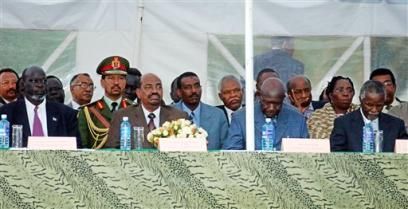FACTBOX-Key terms of pacts to end Sudan’s 21-year war

NAIROBI, Dec 31 (Reuters) – Following are key terms of six peace protocols signed previously by the Sudanese government and Sudan People’s Liberation Movement (SPLM) rebels, who have fought a civil war in the oil-producing south for 21 years.
The combatants signed two further protocols on Friday intended to seal a permanent truce and set out how to implement all the separate protocols, which together constitute a comprehensive peace deal.
The terms of the protocols apply to a so-called pre-interim period of six months following the final peace deal, and also to a further six-year interim period.
Machakos Protocol: Signed July 20, 2002
The people of southern Sudan will have the right to vote for secession at the end of a six-year interim period during which Islamic sharia law will apply in the north but not in the south.
Security arrangements: Signed Sept 25, 2003.
During the interim period there will be two armies — the Sudanese Armed Forces (SAF) and the SPLA.
The parties agree to an internationally monitored ceasefire which shall come into effect on the date a comprehensive peace agreement is signed.
Joint integrated forces to be deployed to southern Sudan, Nuba Mountains, Southern Blue Nile and Khartoum.
Wealth-sharing: Signed Jan 7, 2004
Fifty percent of net oil revenue derived from oil producing wells in southern Sudan shall be allocated to the government of southern Sudan at the beginning of the pre-interim period. The remaining 50 percent to go to the national government and states in northern Sudan.
An Islamic banking system shall operate in northern Sudan and a conventional banking system in southern Sudan.
Power-sharing: Signed May 26, 2004
Before elections, the national executive will be split with the ruling National Congress Party (NCP) taking 52 percent of the seats, the Sudan People’s Liberation Movement (SPLM) 28 percent, other northern parties 14 percent and other southern parties six percent.
The current SPLM chairman shall be first vice-president.
In a regional administration for northern Sudan, the NCP receives 70 percent of executive and legislative seats, the SPLM 10 percent and other southern political parties 20 percent.
In a southern government, the SPLM will take 70 percent of seats in the cabinet and assembly, with 15 percent each to other southern southern forces and the NCP.
Protocol on resolution of conflict in Nuba Mountains and Southern Blue Nile: Signed May 26, 2004
The executive and legislature in the two states will be split with 55 percent going to the NCP and 45 percent to the SPLM. There will be a rotating governorship with each side holding the office of governor for half the pre-election period.
Protocol on the resolution of conflict in Abyei: Signed May 26 2004.
Residents to be citizens of both north and south Sudan. Net oil revenues to be divided six ways during the interim period: 50 percent for the national government, 42 percent for the government of South Sudan, and two percent each for (southern) Bahr el Ghazal region, (northern) Western Kordofan, Ngok Dinka people and Misseriya people.
After interim period, Abyei may vote on whether to keep special administrative status in the north or become part of Bahr el Ghazal, a province of southern Sudan.
